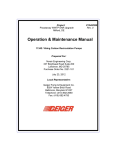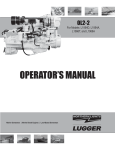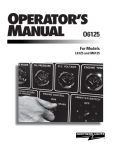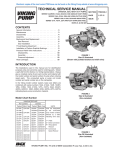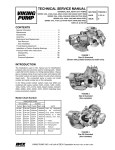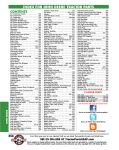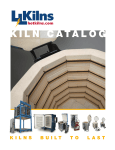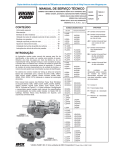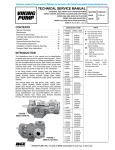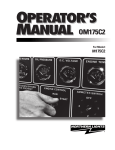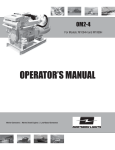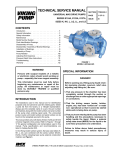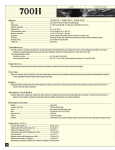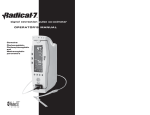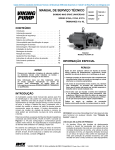Download OPERATOR`S MANUAL
Transcript
OMP For Models: MP445D, MP668D, MP445T, MP668T, MP668QT, MP445H, MP668H, MP40C, MP55C, MP65C, MP80C, and MP99C OPERATOR’S MANUAL Marine Generators | Marine Diesel Engines | Land-Based Generators — CALIFORNIA — Proposition 65 Warning: Diesel engine exhaust and some of its constituents are known to the State of California to cause cancer, birth defects, and other reproductive harm. Northern Lights 4420 14th Avenue N.W. Seattle, WA 98107 Tel: (206) 789-3880 Fax: (206) 782-5455 Copyright ©2002 Alaska Diesel Electric, Inc. All rights reserved. Northern Lights™, and the Northern Lights logo are trademarks of Alaska Diesel Electric, Inc. Printed in U.S.A. PART NO.: OMP 06/02 OPERATOR'S MANUAL #O-MP for Models MP445D, MP668D, MP445T, MP668T, MP668QT, MP445H, MP668H, MP40C, MP55C, MP65C, MP80C, and MP99C Read this operator's manual thoroughly before starting to operate your equipment. This manual contains information you will need to run and service your new unit. Table of Contents INTRODUCTION ....................................................2 Models Included .................................................2 Model Numbers ..................................................2 Serial Numbers ...................................................2 Injector Service ........................................ 16 - 17 Injection Pump ......................................... 17 - 19 Turbocharger .................................................... 20 Turbo Boost ..................................................... 20 Cooling System - General ................................ 20 Engine Coolant Specifications ................. 20 - 21 Cooling System Flushing ................................. 22 Heat Exchanger Cleaning ................................ 22 Cleaning Gear Oil Coolers............................... 22 Zinc Electrodes ........................................ 22 - 23 Raw Water Pump ............................................. 23 Generator Ends ................................................ 23 Electrical System - General ............................. 23 Booster Batteries .............................................. 24 Battery Care ..................................................... 24 Winterizing / Out-of-Service ........................... 24 WARRANTY ............................................................3 SAFETY RULES .....................................................3 COMPONENT LOCATIONS MP445D ..............................................................4 MP445H ..............................................................5 MP668T ..............................................................6 ENGINE & GENERATOR CONTROL PANELS Series 1, 3 & 4 ..............................................7 - 8 OPERATING PROCEDURES Before Starting ....................................................9 Generator Sets .............................................9 - 10 Shutdown Procedures .........................................9 Break-In Period ................................................ 10 TROUBLESHOOTING Electrical .......................................................... 25 Engine ...................................................... 25 - 26 DATA SHEETS Unit Specifications ........................................... 27 SERVICING SCHEDULE CHART .....................11 SERVICE RECORD ............................................ 12 HEAT EXCHANGER DRAWING .................................................................. 28 SERVICING Lubrication - General ....................................... 13 Checking Oil .................................................... 13 Oil Changes ..................................................... 13 Changing Oil Filter .......................................... 13 Air Filter .......................................................... 13 Valve Clearances .............................................. 14 Fuels - General ......................................... 14 - 15 Fuel Filters ....................................................... 15 Bleeding the Fuel System ................................ 15 WIRING DIAGRAMS DC Electrical 12V.................................... 29 - 30 DC Electrical 24V.................................... 31 - 32 ON-BOARD SPARE PARTS.............................. 33 Proprietary Information This publication is the property of Alaska Diesel Electric, Inc. It may not be reproduced in whole or in part without the written permission of Alaska Diesel Electric, Inc. © Alaska Diesel Electric, Inc. All rights reserved. Litho U.S.A. Publication number OMP 06/02 OMP 06-02 1 Introduction Failures begin with minor problems that are overlooked and become amplified when not corrected during routine maintenance. Servicing of marine engines and generator sets presents unique problems. In many cases boats cannot be moved to a repair facility. Marine engines cannot be compared to the servicing of automobiles, trucks or even farm equipment. Failures often occur in remote areas far from competent assistance. Marine engines are taxed far more severely than auto or truck engines; therefore, maintenance schedules must be adhered to more strictly. As operator, it is your obligation to learn about your equipment and its proper maintenance. This is not a comprehensive technical service manual. Nor will it make the reader into an expert mechanic. Its aim is to aid you in maintaining your unit properly. Model Numbers Model numbers give the unit's application, block model, aspiration, and RPM: 445 (4045) or 668 (6068) MP MP - Northern Lights marine generator set Model number 4 Cylinder 4.5 Liters Model number 6 Cylinder 6.8 Liters + MP445D, MP668D = Northern Lights® naturally aspirated, 1800 RPM marine diesel generator set with a John Deere Powertech 4045 or 6068 engine block. MP445T, MP668T = Northern Lights® turbocharged marine generator set with a John Deere Powertech 4045Hor 6068H engine block. MP668QT = MP445H, MP668H MP40C D, T, Q & H + D - Naturally aspirated T - Turbocharged Q - 1200 RPM H - High output 55 kW Northern Lights® commercial marine generator set with a John Deere Powertech 4045T engine block. MP55C = MP65C = 65 kW Northern Lights® high output marine generator set with a John Deere Powertech 4045T engine block. Northern Lights® turbocharged, 1200 RPM marine generator set with a John Deere Powertech 6068 engine block. MP80C = 80 kW Northern Lights® commercial marine generator set with a John Deere Powertech 6068T engine block. = Northern Lights® high output marine generator set with a John Deere Powertech 4045H or 6068H engine block. MP99C = 99 kW Northern Lights® commercial marine generator with a John Deere Powertech 6068T engine block. = 40 kW Northern Lights® commercial marine generator set with a John Deere Powertech 4045D engine block. Serial Numbers When referencing Alaska Diesel Electric equipment by serial number, please refer only to the number stamped on the Northern Lights® serial number plate. OMP 06-02 2 Warranty A warranty registration certificate is supplied with your set. The extent of coverage is described in the Limited Warranty Statement. We recommend that you study the statement carefully. followed. If further information is needed, please contact an authorized dealer or the factory. NOTE: If the warranty is to apply, the servicing instructions outlined in this manual must be Safety Rules CAUTION: Accident reports show that careless use of engines causes a high percentage of accidents. You can avoid accidents by observing these safety rules. Study these rules carefully and enforce them on the job. • Use caution in handling fuel. Never refuel a hot or running engine. Do not smoke while filling fuel tank or servicing fuel system. • Never leave engine without proper security. • Turn the coolant tank cap slowly to relieve pressure before removing. Add coolant only when the engine is stopped and cool. • Keep your hands, feet, hair and clothing away from power-driven parts. • Mount a fire extinguisher near engine. • Check for any loose electrical connections or faulty wiring. • Always disconnect the battery ground strap before making adjustments. • Engines should be operated only by knowledgeable, qualified personnel. • Operate engines in properly ventilated areas. • Keep trash and other objects away from engine. • Look completely around engine to make sure that everything is clear before starting. • Escaping fluids under pressure can penetrate your skin. Use a piece of cardboard or wood, not your hands, to search for leaks. • Avoid wearing loose clothing when working around engines. • Do not operate an engine that isn't in proper working order. If an unsafe operating condition is noted, tag the set and control panel so others will also know about the problem. • Do not oil or grease engine while it is running. • Provide first aid kits. CALIFORNIA Proposition 65 Warning: CAUTION: This symbol is used throughout this book to alert you to possible danger areas. Please take special notice of these sections. Diesel engine exhaust and some of its constituents are known to the State of California to cause cancer, birth defects, and other reproductive harm. OMP 06-02 3 MP Component Locations Figure 1: MP445D 1. 2. 3. 4. 5. 6. 7. Expansion Tank Raw Water Pump Drive Belt Lube Oil Fill Lube Oil Filter Fuel Lift Pump Lube Oil Dipstick 8. 9. 10. 11. 12. 13. 14. Lube Oil Drain Electric Starter Fuel Manifold DC Circuit Breaker Air Cleaner D.C. Alternator Wet Exhaust Elbow 15. 16. 17. 18. 19. 20. 21. Exhaust Manifold Drain Engine Block Drain Fuel Injection Pump Heat Exchanger Zinc (2) Heat Exchanger Drain Heat Exchanger Coolant Fill OMP 06-02 4 22. 23. 24. 25. Thermostat Cover Fuel Injectors (4) A.V.R. Fuse Fuel filter MP Component Locations Figure 2: MP445H (note: MP445T models have similar component locations). 1. Expansion Tank 2. Injection Pump Drive Coupling Access Cover Plate 3. Drive Belt Cover 4. Lube Oil Fill 5. Lube Oil Filter 6. Optional Power Takeoff 7. 8. 9. 10. 11. 12. 13. 14. Optional Flow Switch Fuel Lift Pump Lube Oil Dipstick Fuel Manifold Lube Oil Drain Electric Starter DC Circuit Breaker Air Cleaner 15. Optional Governor Actuator 16. DC Alternator 17. Wet Exhaust Elbow 18. Exhaust Manifold Drain 19. Engine Block Drain 20. Fuel Injection Pump 21. Optional Hydrolastic Mount OMP 06-02 5 22. 23. 24. 25. 26. 27. 28. 29. 30. Heat Exchanger Zinc (2) Heat Exchanger Drain Heat Exchanger Coolant Fill Thermostat Cover Fuel Injectors (4) Turbocharger A.V.R. Fuse Fuel Filter MP Component Locations Figure 3: MP668T (note: components of MP668QT are in a similar location). 1. 2. 3. 4. 5. 6. 7. 8. Coolant Fill Expansion Tank DC Alternator Lube Oil Fill Lube Oil Filter Fuel Lift Pump Lube Oil Dipstick Lube Oil Drain 9. 10. 11. 12. 13. 14. 15. 16. Air Cleaner DC Circuit Breaker Turbocharger Wet Exhaust Elbow Exhaust Manifold Drain Electric Starter Engine Block Drain Fuel Injection Pump 17. 18. 19. 20. 21. 22. 23. Heat Exchanger Zinc (2) Heat Exchanger Drain Heat Exchanger Raw Water Pump Fuel Injectors (6) Thermostat Cover Optional Hydrolastic Mounts OMP 06-02 6 24. Optional Governor Actuator 25. Drive Belt Cover 26. Fuel Manifold 27. A.V.R. Fuse 28. Fuel Filter Northern Lights Control Panels 1. SHUTDOWN BYPASS SWITCH This switch bypasses the safety shutdown feature during the starting process. 2. ENGINE CONTROL SWITCH To start the engine, hold this switch in the START position until the engine is running. NOTE: Excessive cranking of marine sets equipped with water lift muffler systems can cause engine damage. After the engine starts, release the switch and it will return to RUN position. To stop the engine, hold the switch in the STOP position. NOTE: The rocker switch is used on Series 1 panels only, and has a light that glows when the set is running. 3. OIL PRESSURE GAUGE Figure 4-A: Series 3 Generator Control Panel The oil pressure gauge shows the oil pressure in the engine lubricating system. If the pressure drops below 15 PSI at a speed higher than idling, stop the engine and investigate. 4. COOLANT TEMPERATURE GAUGE Water temperature gauge shows the temperature of the cooling water. If the gauge registers over 200° or drops below 140°, stop the engine and investigate. 5. HOUR METER Figure 4-B: Series 1-B Generator Control Panel Keeps track of the engine running time. 6. DC VOLTMETER When the engine is running, it indicates the voltage output of the alternator. Figure 4-C: Series 3C Generator Control Panel OMP 06-02 7 Northern Lights Control Panel Figure 5: Series 4 Generator Control Panel 7. AC VOLTMETER 1. SHUTDOWN BYPASS SWITCH The voltmeter shows the generator output voltage, phase to phase. If the voltage fluctuates greatly from the normal reading, shut down the unit and investigate. This switch bypasses the safety shutdown feature during the starting process. 2. ENGINE CONTROL SWITCH The control switch starts and stops the engine. 8. FREQUENCY METER 3. OIL PRESSURE GAUGE Indicates engine speed. The correct reading for 1800 and 1200 RPM sets is 60 Hz. For 1500 RPM sets, it is 50 Hz. If meter does not indicate correct hertz, stop and investigate. The oil pressure gauge shows the oil pressure in the engine lubricating system. If the pressure drops below 15 PSI at a speed higher than idling, stop the engine and investigate. 9. AMMETER SELECTOR SWITCH 4. COOLANT TEMPERATURE GAUGE The ammeter switch is used for checking each phase for load condition. Leave it in the ON position while the engine is running. Water temperature gauge shows the temperature of the cooling water. If the gauge registers over 200° or drops below 140°, stop the engine and investigate. 10. AC AMMETER 5. HOUR METER The ammeter indicates the phase load. Check for load unbalance. If the unbalance is greater than 30%, have an electrician balance the load properly. This will ensure longer generator life and better economy. Keeps track of the engine running time. 6. DC VOLTMETER When the engine is running, it indicates the voltage output of the alternator. OMP 06-02 8 Operating Procedures BEFORE STARTING 1. Check the water level by removing the pressure cap from the expansion tank. In order to give the cooling water room to expand, the level should be about 1 3/4 in. (4-5 cm) below the filler cap sealing surface when the engine is cold. When filling with coolant, the venting cock on top of the turbocharger should be opened to ensure that no air pockets form in the cooling system (see Service Point #14). 3. Let the unit run unloaded for a three to five minute warm-up period before applying load. 4. Do not add full electrical load until engine is at maximum operating temperature. Shutdown 1. Unload the generator and run for three to five minutes for cool down period. 2. Turn the Engine Control Switch to the OFF position. 3. Close the sea cock and fuel valves, and put the battery switch in the OFF position if the unit will be off for an extended period. CAUTION: Use protective clothing and open the filler cap carefully when the engine is warm to prevent burns. NOTE: Do not turn the battery switch to OFF while the engine is running. 2. Check the oil level in the crankcase with the dipstick. The oil level should be between the “waffled area” and the “oo”. Never allow the level to go below the “oo”. Always add the same viscosity of oil as is already in the crankcase (see Service Point #1). 3. Check the fuel tank level and open any fuel valves. 4. Close the seacock, check and clean the strainer and reopen the seacock. 5. Place the battery switch in the ON position. SHUTDOWNS AND ALARMS 1. Your unit is fitted with a system to protect it from high water temperature or low oil pressure. a. Generator sets have shutdown systems to stop the engine. They have no warning horns. b. Other alarms and shutdowns are available as optional equipment. NOTE: The battery switch must always be kept ON while the engine is running. If the switch is turned OFF while the engine is running, the battery charging regulator could be ruined. NOTE: Do not rely on your warning or shutdown system to the exclusion of careful gauge monitoring. Watching your gauges can prevent damage to the unit and dangerous power losses. GENERATOR 2. Do the following when your shutdown system is activated: Starting 1. While holding the Shutdown Bypass switch in the ON position, push the Engine Control switch to the START position 2. As soon as the engine starts, release both switches. Do not crank the starter for more than 20 seconds. 3. If the engine fails to start the first time, be sure the starter has stopped before reengaging. a. Check the temperature gauge. If the temperature is above 205°F (97°C), shut off the engine immediately. b. Use the Trouble Shooting Guide on pages 25- 26 to isolate the cause of the overheat. CAUTION: Do not remove the water fill cap of an overheated engine. Escaping high temperature steam can cause severe burns. Allow the engine to cool and then remove the cap slowly, using protective clothing. Operating 1. Check Gauges Often: Oil pressure must be above 29 PSI. The D.C. voltmeter should read between 13 and 14 volts (26-28 volts, 24 volt systems) at 60°F (16°C) ambient temperature. Water temperature gauge must be below 200°F (94°C). 2. Check AC voltage and frequency meters (Series 4 Panel). If gauges deviate from normal levels, shut down the set and investigate. c. Make repairs and restart after the temperature gauge registers below 180°F (83°C). d. Watch the temperature gauge regularly and turn off the unit if the temperature rises above 200°F (94°C). Repeat the troubleshooting process. OMP 06-02 9 Operating Procedures 3. If the shutdown is activated and the temperature gauge shows temperature within normal temperature range: a. Check the engine crankcase oil level. b. If the oil level is low, fill with recommended lubricating oil and restart. Watch the oil pressure gauge carefully and shut off the engine if it does not show a normal reading after a few seconds of operation. c. If the oil level is normal, DO NOT restart the engine. Call your Northern Lights or Lugger dealer for assistance. BREAK-IN PERIOD 1. The first 100 hours on a new or reconditioned engine are critical to its life and performance. 2. Constantly check the engine temperature and oil pressure gauges. 3. Oil consumption is greater during break-in as piston rings and cylinder liners take time to seat. 4. Break-In Oil Changes: Change engine oil and filter at 50 hours. Change oil and filter again at 100 hours (See Gear Owner's Manual for break-in oil change procedures. Consult Lubricants Section for oil recommendation). OPERATING INSTRUCTIONS Generator sets: Maintain at least a 75% load on your set for the first 100 hours. If this is not possible, maintain no less than a 50% load to ensure proper seating of the piston rings. Vary the load to help seat rings. OMP 06-02 10 Servicing Schedule Chart The Servicing Schedule Chart below shows the service schedule required for proper maintenance of your marine engine or generator set. More detailed coverage of each Service Point (SP) is listed on the page noted in the ‘page’ column. SP18 Check zinc electrodes DAILY: SP1 Check oil level in engine SP7 Check primary fuel filter SP14 Check cooling water level AFTER FIRST 600 HOURS: SP6 Adjust valves EVERY 600 HOURS / YEARLY: SP4 Replace air cleaner SP5 Check V-belt condition SP9 Change secondary fuel filter SP10 Check injectors SP13 Check turbocharger boost pressure SP15 Check and flush cooling system SP19 Change impeller in raw water pump SP23 Check the state of the charge of the batteries AFTER FIRST 50 HOURS: SP2 Change engine oil SP3 Change lube oil filter EVERY 50 HOURS: SP22 Check electrolyte in batteries FIRST 100 HOURS: SP2 Change engine oil SP3 Change lube oil filter EVERY 1200 HOURS: SP6 Adjust valves EVERY 250 HOURS: SP2 Change engine oil SP3 Change lube oil filter SP4 Check air cleaner SP8 Change primary fuel filter element SP12 Check turbocharger air, oil & cooling lines for leakage SERVICE POINT PAGE EVERY 2400 HOURS: SP11 Check fuel injection pump SP16 Check and clean heat exchanger SP17 Check and clean gear oil cooler OPERATION DAILY ENGINE: SP1 SP2 SP3 SP4 SP5 SP6 14 14 14 14 SP7 SP8 SP9 SP10 SP11 16 16 16 17-18 18-20 SP12 SP13 21 21 SP14 SP15 SP16 SP17 SP18 SP19 12 & 23 23 23 15 Check oil level Change engine oil Change lube oil filters Check (replace) air cleaner Check belt condition Check valve clearances • 1) 1) 1) 3) 1) 1) • 2) 2) 3) 1) 3) 1) • 1) COOLING SYSTEM: 23-24 24 Check cooling water level Check and flush cooling system Check and clean heat exchanger Check and clean gear oil cooler Check zinc electrodes Change impeller in raw water pump 25 25 Check electrolyte level in batteries Check condition of batteries with hydrometer SP24 27 Winterizing or out-of-service • 1) 1) 1) 1) 3) 1) 3) • 1) 3) 1) OUT OF SERVICE: 3) 1) Perform all maintenance once a year even if hour level has not been reached. 2) Consult manufacturer's maintenance schedule, note on chart. 3) Whenever necessary. OMP 06-02 11 600 Hours 1200 Hours 2400 Hours • • • • • • • • • • ELECTRICAL SYSTEM: SP22 SP23 • TURBOCHARGER: Check air, oil & cooling water lines for leakage Check boost pressure 250 Hours • • • FUEL SYSTEM: Check primary filter (Racor) Change primary filter element (Racor) Change secondary fuel filter Check injectors Check fuel injection pump 50 Hours • • • Service Record Service Point OPERATION HOURS/DATE 50 HOURS SP23 Check electrolyte in batteries 250 HOURS SP2 Change engine oil SP3 Change lubricating oil filters SP4 Check air cleaner SP7 Change primary fuel filter element SP12 Check turbocharger air, oil & cooling lines for leakage SP18 Check zinc electrodes 600 HOURS SP4 Replace air cleaner SP5 Check belt condition SP9 Change secondary fuel filter SP10 Check injectors SP13 Check turbocharger boost pressure SP15 Check and flush cooling system SP19 Change impeller in raw water pump SP23 Check state of charge of batteries EVERY 1200 HOURS SP6 Check valve clearances 2400 HOURS SP11 Check fuel injection pump SP16 Check and clean heat exchanger SP17 Check and clean reverse gear oil cooler OMP 06-02 12 Servicing LUBRICATION Break-in oil 1. Use one of the following during the first 100 hours of operation: a. John Deere Engine Break-In Oil b. API Service CE oil c. ACEA Specification E1 2. Do not use John Deere PLUS-50 oil or engine oils meeting API CG4, API CF4, ACEA E3, or ACEA E2 performance levels during the first 100 hours of operation of a new or rebuilt engine. These oils will not allow the engine to break-in properly. Lubrication - General 1. Use only clean, high quality lubricants stored in clean containers in a protected area. 2. These oils are acceptable after the first 100 hours: a. API Service CC/CD single viscosity oils. b. API Service CD/CG-4/CF-4 multi-viscosity oils. c. ACEA Specification E3/E2 multi-viscosity oils. d. CCMC Specification D5 and Mercedes Benz MB228.3. e. CCMC Specification D4 and Mercedes Benz MB228.1. 3. Use the proper weight oil for your average operation temperature. Air Temperature Single Viscosity Multi Viscosity Above 32°F (0°C) SAE-30W SAE15-40W -10°F to 32°F (-23°C to 0°C) SAE-10W SAE10-30W Below -10°F (-23°C) SAE-5W SAE5-20W SP2. OIL CHANGES 1. Using the oil recommended above, change the engine oil and filter after the first 50 hours of operation, the first 100 hours and every 250 hours thereafter. 2. During intermittent cold weather operation, change oil every 100 hours or six weeks, whichever comes first. 3. Change oil at any seasonal change in temperature when a new viscosity of oil is required. Marine Generator Sets: a. Remove plug from outlet in base frame. Screw in owner-supplied drain hose. b. Open valve at oil pan outlet. After oil has been drained into suitable container, close valve, remove drain hose and replace plug in base frame outlet. c. Refill engine with recommended oil. 4. Engine Lube Oil Capacity: 445 Series 14 qts. 13.2 liters 668 Series 18 qts. 17.0 liters SP3. CHANGING OIL FILTER 1. Change the lube oil filter every 250 hours. 2. Use a filter wrench to remove old filter. Dispose of filter in approved manner. 3. Make sure the gasket from the old filter is removed and discarded. 4. Lubricate the rubber gasket on the new filter and screw it on nipple until gasket meet the sealing surface. 5. Using hands only, no wrench, tighten filter one-half turn farther. Overtightening can do damage to filter housing. 6. Fill engine with recommended oil. Start engine and check for leakage. Stop engine and check oil level. Add additional oil if necessary. SP4. AIR CLEANER 1. Inspect air cleaner every 100 hours. Replace filter every 600 hours, or yearly, whichever comes first. 2. Clean the rubber tube at the cleaner. Loosen the hose clamp and the attaching strip for the cleaner. 3. Make sure the rubber tube is in good condition and that new filter is absolutely clean and installed properly. 4. Start the engine and check for leaks. 4. Some increase in oil consumption may be expected when SAE 5W and SAE 5-20W oils are used. Check oil level frequently. 5. Never put additives or flushing oil in crankcase. SP1. CHECK ENGINE OIL LEVEL 1. Check the oil level in the crankcase, with the oil dipstick, daily. 2. The oil level must be between the “Waffled area” and the “oo”. Never allow the level to go below the “oo”. 3. Always add the same viscosity of oil as is already in the crankcase. NOTE: Make absolutely sure no impurities enter the engine while changing the element. Do not run the engine with the air cleaner removed. OMP 06-02 13 Servicing SP6. VALVE CLEARANCES The following special tools will be needed: JDE 820 or JDE 83 Flywheel Turning Tool. JDE 81-4 Timing Pin. 1. Check the valve clearances after the first 600 hours, the first 1200 hours and every 1200 hours thereafter. 2. Remove rocker arm cover with ventilator tube. 3. Remove plastic plugs in engine timing holes on front side of flywheel. 4. Rotate flywheel in clockwise direction (viewed from water pump) with the Flywheel Turning Tool until the Timing Pin engages timing hole in the flywheel. Both rocker arms for No. 1 cylinder will be loose at Top Dead Center. If they are not, remove the timing pin and rotate the flywheel one complete turn and reinstall the timing pin in the flywheel. 5. Valve clearances must be checked with the engine cold. Intake Valve: 0.012-0.015 in. (0.31-0.38 mm) Exhaust Valve: 0.016-0.019 in. (0.41-0.48 mm) 6-CYLINDER ENGINES: NOTE: Firing order is 1 - 5 - 3 - 6 - 2 - 4 Reproduced by permission of Deere & Company, c2000. Deere & Company. All rights reserved. A B C E F 4-CYLINDER ENGINES: - Front of Engine No. 1 Piston at TDC Compression Stroke No. 6 Piston at TDC Compression Stroke Exhaust Valve Intake Valve Lock No. 1 piston at TDC compression stroke (B). NOTE: Firing order is 1 - 3 - 4 - 2 Adjust valve clearance on No. 1, No. 3, and No. 5 exhaust valves and No. 1, No. 2, and No.4 intake valves. Rotate flywheel 360°. Lock No. 6 piston at TDC compression stroke (C). Adjust valve clearance on No. 2, No. 4, and No. 6 exhaust valves and No. 3, No. 5, and No. 6 intake valves. FUELS - GENERAL 1. Use only clean, high quality fuels of the following specifications, as defined by ASTM designation D975 for diesel fuels: a. Use grade no. 2 diesel at ambient temperatures above freezing 30°F (0°C). b. Use grade No.1 at ambient temperatures below freezing and for all temperatures at an altitude of above 5,500 ft. (1500 meters). 2. Sulphur content should not exceed 0.5% (preferably less than 0.5%). 3. The cetane number should be a minimum of 45. 4. DO NOT use these unsuitable grades of fuel: a. Domestic heating oils, all types. b. Class B engine. c. Class D domestic fuels. d. Class E, F, G or H industrial or marine fuels. e. ASTM-D975-60T No. 4-D and higher number fuels. f. JP4 Reproduced by permission of Deere & Company, c2000. Deere & Company. All rights reserved. A B C E F - Front of Engine No. 1 Piston at TDC Compression Stroke No. 4 Piston at TDC Compression Stroke Exhaust Valve Intake Valve Lock No. 1 piston at TDC compression stroke (B). Adjust valve clearance on No. 1 and No. 3 exhaust valves and No. 1 and No. 2 intake valves. Rotate flywheel 360°. Lock No. 4 piston at TDC compression stroke (C). Adjust valve clearance on No. 2 and No. 4 exhaust valves and No. 3 and No. 4 intake valves. OMP 06-02 14 Servicing NOTE: Before installing a new filter cartridge make sure the surfaces where the cartridge comes in contact with the mounting plate are absolutely clean. Dirt can be washed into the fuel injection system. This may result in severe damage to the fuel injection pump or nozzles. FUELS - GENERAL (continued) 5. Storing fuel: a. Keep dirt, scale, water and other foreign matter out of fuel. b. Avoid storing fuel for long periods of time. c. Fill the fuel tank at the end of each day's operation. This will reduce condensation. SP7-9. FUEL FILTERS 1. Your engine or generator set should have a primary fuel filter installed. We recommend the Racor brand of fuel filter - water separators. a. Check the primary fuel filter daily as recommended by the filter manufacturer. Empty the collection bowl as necessary. b. Change the element every 250 hours or whenever necessary. c. If the bowl fills with water, change the primary and secondary elements immediately. 2. Change secondary fuel filter every 600 hours. d. Install new filter cartridge. e. Fuel filter cartridge number is: 24-51005 f. Turn on the fuel. BLEEDING THE FUEL SYSTEM CAUTION: Escaping diesel fuel under pressure can penetrate the skin, causing serious personal injury. Before disconnecting lines be sure to relieve all pressure. Before applying pressure to the system be sure all connections are tight and the lines, pipes and hoses are not damaged. Fuel escaping from a very small hole can be almost invisible. Use a piece of cardboard or wood rather than the hands to search for suspected leaks. If injured by escaping fuel, see a doctor at once. Serious infection or reaction can develop if proper medical treatment is not administered immediately. NOTE: The fuel filter on the engine is considered the “secondary fuel filter”. The engine will be fitted with a quick change disposable secondary fuel filter. 1. Whenever the fuel system has been opened for service, (lines disconnected, filter changed, etc.) it will be necessary to bleed air from the system. a. To bleed the fuel system, loosen the bleed plug (Figure 6-D) on the fuel filter. Operate the primer pump lever on fuel transfer pump (see component locations) until most of the air bubbles are expelled and clear fuel escapes the bleed plug. Tighten the bleed plug. b. If the engine will not start, it may be necessary to loosen the fuel supply pipe at the pump. Operate primer lever of fuel supply pump until fuel flow is free from air bubbles. Retighten fuel supply line to 22 ft. lb. (30 N•m). c. If engine still doesn't start, loosen fuel line connection at injection nozzle. Always use a back up wrench when loosening or tightening fuel lines at nozzles and injection pump to avoid damage. With throttle on full, crank the engine over with the starter until fuel without air flows from the loose fuel pipe connection. Repeat procedure for remaining nozzles, if necessary, until engine starts or until air has been removed from system. Tighten the connections to 20 foot lb. (27 N•m). a. Turn off the fuel. b. Open the filter drain plug (Figure 6-A) and drain the filter. Figure 6: Secondary Fuel filter c. Remove the secondary fuel filter by turning the filter clamp (Figure 6-B) counter clockwise until the filter cartridge (Figure 6-C) slides out. OMP 06-02 15 Servicing SP10. INJECTORS 1. Fuel injectors should be checked by a Lugger-Northern Lights dealer or qualified fuel injection shop every 600 hours. 2. Injector Removal: You will need the following special tools: JDE38A—Injection Nozzle Puller JDE39—Nozzle Bore Cleaning Tool JD258—Pilot Tool a. Before removal, carefully remove all dirt from the cylinder head around fuel injection nozzles. Clean with compressed air to prevent dirt from entering the cylinders or valve seats. Plug the bore in the cylinder head after each fuel injection nozzle has been removed. Cap fuel line openings as soon as they are disconnected. b. Immediately fit protective caps over the nozzle tips and the line connections to avoid handling damage. c. Do not bend the fuel delivery lines. When loosening the fuel pressure lines, hold male union of nozzle line stationary with a backup wrench. d. Loosen nuts to remove leak-off lines and T-fittings and disconnect fuel injection line from nozzle. b. Clean exterior of nozzle by soaking in clean solvent or diesel fuel. Clean tip with brass wire brush. Figure 7 Reprinted by permission of Deere & Company, RG6300 Deere & Company, All rights reserved. NOTE: Do not scrape or disturb the teflon coating on the nozzle body above the carbon stop seal groove. This coating will become discolored during normal operation, but this is not harmful. Do not use a motor driven brush to clean up nozzle body. NOTE: When all fuel injection nozzles have to be removed, disconnect leak-off line assembly at fuel tank, at injection pump, and at each nozzle T-fitting. Lift off complete leak-off line as an assembly. e. Remove cap screw, clamp and spacer. f. Pull injection nozzle out of cylinder head with JDE38A Injection Nozzle Puller. Figure 8 5. Install seals on injection nozzle. NOTE: Each time an injection nozzle is removed from the cylinder head, replace carbon stop seal (B) with a new one. NOTE: Do not use screwdrivers, pry bars, or similar tools for this as they might damage the injection nozzle. 3. Clean Injector Bore: Always turn the tool clockwise through the bore even when removing from bore, otherwise tool may become dull. a. Clean nozzle bore with JDE39 Nozzle Bore Cleaning Tool. Blow debris from bore with compressed air and plug the bore to prevent entry of foreign material. 4. Clean injection nozzles: a. Remove carbon stop seal (Figure 7-A) and upper sealing washer (Figure 7-B), using a needle-nose pliers. Discard seals. a. Position JD258 (ROS16477) Pilot Tool (Figure 8-C) over nozzle tip. If Pilot Tool (included in cleaning kit) is not available, use a No. 16189 Nozzle Protector Cap found on every new or replacement nozzle. b. Position a new carbon stop seal (Figure 8-B) on pilot tool. Use a new seal washer (Figure 8-A) to help slide the carbon seal into place until it seats in its groove on nozzle body. c. Continue to slide upper sealing washer onto nozzle body until it seats against inlet fitting. OMP 06-02 16 Servicing 6. Install injection nozzles: NOTE: Before installing injection nozzles, make sure nozzles are clean and free from oil or grease. Do not grease or oil the nozzles. a. Remove plug (if installed previously) from nozzle bore in cylinder head and blow out bore with compressed air. b. Make sure that the sealing surface of the cylinder head (on which the seal washer will be resting) is smooth and free of damage or dirt. This could prevent proper sealing. Dirt and roughness could also cause distortion to nozzle when the attaching screw is tightened, making the valve stick. c. Install nozzle in cylinder head using a slight twisting motion as nozzle is seated in bore. 2. Black smoke can be an indication of pump malfunctions. Before servicing pump, check the other possible causes. a. Check cleanliness of air filter. b. Check valve clearances. c. Clean and check injectors. 3. Any repair which involves disassembly of the injection pump must be carried out by specially-trained mechanics with the proper tools and test devices. NOTE: All warranties on the engine become null and void if the injection pump seals are broken by unauthorized persons. DB4 AND DB2 INJECTION PUMPS – REMOVAL All Stanadyne DB2 and DB4 injection pumps will have a retained drive shaft (shaft stays in pump when pump is removed from engine). 1. Clean the fuel injection pump, lines and area around the pump with cleaning solvent or a steam cleaner. IMPORTANT: Never steam clean or pour cold water on a fuel injection pump while the pump is running or while it is warm. Doing so may cause seizure of internal rotating pump parts. Figure 9: Shows relationship of parts required for installation. d. Install spacer and cap screw. Do not tighten capscrew at this stage. e. Connect fuel pressure line to nozzle. Leave connection slightly loose until air is bled from system. f. Tighten nozzle hold-down cap screws to 27 foot lb. (37 N•m). g. Install leak-off assembly. h. Bleed air from loose injection line connection. Tighten connection using two wrenches. SP13. INJECTION PUMP 1. Since operating conditions may vary considerably, it is difficult to give a definite service interval. But, as a rule, the pump settings, maximum speed, idle speed and exhaust smoke should be checked by your dealer after every 2400 hours of operation. Service of the fuel injection pump should only be done if checks indicate pump malfunction. 2. Disconnect shutoff cable and speed control linkage or cold start switch, if equipped. Disconnect electrical connection to shutoff solenoid or throttle positioning solenoid. Tag electrical wires for correct reassembly. IMPORTANT: Always use a backup wrench when loosening or tightening fuel lines at injection pump so that discharge fittings are not altered which will prevent internal pump damage. 3. Disconnect fuel return line (Figure 10-A) and fuel supply line (Figure 10-C). Figure 10 OMP 06-02 17 Reproduced by permission of Deere & Company, c.2000. Deere & Company,. All rights reserved. Servicing IMPORTANT: Injection pump mounting flange timing mark (Figure 12-A ) and front plate timing mark (Figure 12-B) presence and alignment MUST be verified before removing pumps from engine. DO NOT reference internal timing marks (on pump cam ring and governor weight retainer). If timing mark is not clearly visible on front plate, scribe a visible reference mark as accurately as possible in-line with mark on pump flange. 4. Disconnect all fuel delivery (pressure) lines (Figure 10-B) from injection pump using a suitable 17mm deep-well crowsfoot socket. 5. Remove injection pump drive gear cover. Remove drive gear retaining nut and washer from end of pump shaft. Be careful not to let washer fall inside timing gear cover. NOTE: The injection pump drive gear fits snugly onto a tapered drive shaft and indexed by a hollow pin or Woodruff key installed in drive shaft 6. Attach JDG670A Drive Gear Puller (Figure 11-A) to injection pump drive gear as shown. NOTE: Replace 6mm Grade 12.9 cap screws (C) as needed. 7. Evenly tighten the two 6mm, Grade 12.9 screws (threaded in drive gear) and snugly tighten center forcing screw (Figure 11-B) against end of pump shaft. 10. Remove three injection pump mounting stud nuts. Remove injection pump from mounting studs. 11. Plug or cap all openings on injection pump and take pump to dealer for service DB4 & DB2 INJECTION PUMP – INSTALLATION 1. Lubricate a new square sealing ring with clean engine oil. Install ring into groove on front face of pump mounting flange. Slide injection pump onto mounting studs while inserting pump shaft into drive gear. 2. Check pump shaft and index pin for proper alignment with pump drive gear key slot. IMPORTANT: Shaft roll pin may be easily damaged if improperly assembled. Pump drive gear should not move when initially installing pump index pin into drive gear key slot. Figure 11. Reproduced by permission of Deere & Company, c.2000. Deere & Company. All rights reserved. 8. Tighten center forcing screw until pump drive gear is free from tapered shaft. Remove JDG670A puller (Figure 11-A) and screws from drive gear. 9. Check to make sure that timing marks on back side of front plate (Figure 12-A) and injection pump flange (Figure 12-B) are present and properly aligned. This assures that repaired or replacement pump can be properly timed to engine when installed. 3. Install injection pump partially onto mounting studs without engaging pump pilot hub into engine front plate. IMPORTANT: DO NOT tighten hex nuts more than three full turns on mounting studs. Pump drive shaft index pin may be damaged if pin is not properly aligned with drive gear key slot and if the nuts are tightened more than three turns. 4. Install three flat washers, lock washers, and hex nuts onto pump mounting studs. Tighten nuts three turns only so that pump will not fall off mounting studs. NOTE: The pump drive gear should begin to move forward (away from engine front plate) with the pump when flange is approximately 1/8 in. (3.2mm) away from engine front plate. Figure 12. Reproduced by permission of Deere & Company, c.2000. Deere & Company. All rights reserved. OMP 06-02 18 Servicing 5. Install pump mounting flange flush to engine front plate with drive gear held flush against front side of engine front plate. IMPORTANT: Do not use tightening force of pump mounting stud nuts to pull pump shaft into drive gear I.D. 6. With the pump shaft index pin properly engaged in the drive gear key slot, finger tighten mounting stud nuts. 7. Push pump drive gear firmly onto shaft taper. Install washer and retaining nut (Figure 13-C) onto end of shaft. Tighten retaining nut to 90 lb-ft. (122 N•m) for DB2, 150 lb-ft. (203 N•m) for DB4. Figure 15 Reproduced by permission of Deere & Company, c.2000. Deere & Company, All rights reserved. Figure 16 Reproduced by permission of Deere & Company, c.2000. Deere & Company, All rights reserved. Figure 13 Reproduced by permission of Deere & Company, c.2000. Deere & Company, All rights reserved. IMPORTANT: Do not overtighten cap screws on pump cover plate to avoid damage to O-ring. 8. Install access cover plate using a new gasket. Apply LOCITE 242 (TY9370) to cap screw threads and tighten to 1.7 lb-ft. (2 N•m). 9. Align timing mark on the pump flange (Figure 14-B) with timing mark on the cylinder block front plate (A). Figure 14 Reproduced by permission of Deere & Company, c.2000. Deere & Company, All rights reserved. 10. Tighten the three hex nuts securing the pump to the front plate to 20 foot lbs. (27 N•m). 11. Connect injection pump pressure lines (Figure 15-E). Beginning with outlet connection to #1 cylinder (Figure 16-B) and continue around the pump head in counterclockwise direction, attaching lines in same order as engine firing (1-5-3-6-2-4 on 6-cylinder engines and 1-3-4-2 on 4-cylinder engines). 12. Tighten fuel delivery (pressure) lines to 20 foot lbs. (27 N•m), using a suitable 17mm deep-well crowsfoot socket. IMPORTANT: Always use a backup wrench when loosening or tightening fuel delivery lines at fuel injection pump, so that the pump discharge fittings are not altered. This prevents possible internal pump damage. 13. Connect fuel supply line (Figure 15-C) and fuel return line (Figure 15-D). 14. Connect fuel shutoff cable and speed control linkage, if equipped. Install and securely tighten electrical connections to shutoff solenoid and throttle positioning solenoid, if equipped. Connect cold start switch, if equipped. 15. Bleed air from fuel system as outlined on page 15. Start engine and run for several minutes. Check the entire system for leaks. OMP 06-02 19 Servicing SP12. TURBOCHARGER 1. Check for air leaks every 200 hours. Air leakage will lower engine output and may cause black exhaust smoke and soot. 2. Listen along air line while engine is running. A whistling or hissing sound indicates leakage. 3. Leakage on the pressure side, between turbo and engine, can be found by applying soapy water to the air line. 4. Tighten the hose clamps, replace hose or gaskets as required. 5. Check to see that the lubrication and cooling lines are tight and without leaks. 2. Vapor bubbles (Figure 17-C) are formed when the piston's impact causes the liner walls to vibrate, sending pressure waves into the coolant. 3. These tiny vapor bubbles collect on the surface of metal parts. As the bubbles collapse (pop) a microscopic piece of metal is eroded from the metal part. Over a period of time, this pitting may progress completely through the cylinder liner of a wet-sleeve, heavy-duty diesel engine. This allows coolant to enter the combustion chamber. Engine failure or other serious damage will result. SP13. TURBO BOOST 1. This check measures the amount of air the turbo is pushing into the engine. It should be done by an authorized dealer every 600 hours. 2. On the inlet manifold there is a 1/8" NPT threaded port. Remove the plug and install the boost gauge hose. Refer to your engine specifications for correct pressure. A - Cylinder Liner Walls COOLING REQUIREMENTS 1. To meet cooling system protection requirements, the coolant solution must consist of: a. Quality water b. Ethylene glycol concentrate (EGC ) commonly known as antifreeze. c. Supplemental coolant additives (SCA's). 2. A coolant solution of ethylene glycol concentrate (EGC-antifreeze), quality water and supplemental coolant additives (SCA's) MUST be used YEAR ROUND to protect against freezing, boil-over, liner erosion or pitting and to provide a stable, noncorrosive environment for cooling system components. 3. Ethylene glycol coolant concentrate (antifreeze) normally DOES NOT contain the SCA chemical inhibitors needed to control liner pitting or erosion, rust, scale, and acidity. B - Engine Coolant C - Vapor Bubbles Figure 17. 4. Unprotected engines with low quality water as coolant can have liner failure in as few as 500 hours. WATER QUALITY 1. Distilled, deionized, soft water is preferred for use in cooling systems. Bottled distilled water from a food store or water supplier is recommended. Tap water often has a high mineral content. Tap water should NEVER be put in a cooling system unless first tested by a water quality laboratory. Do not use water made by the reverse osmosis method unless it has been PH neutralized. 2. Here are acceptable water quality specifications: Parts per Million Grains per Gallon Maximum Chlorides 40 2.5 Maximum Sulfates 100 5.9 Maximum Dissolved Solids 340 20.0 Maximum Total Hardness 170 10.0 Contaminates LINER EROSION (PITTING) 1. Cylinder liner walls (Figure 17-A) which are in contact with engine coolant (Figure 17-B) can be eroded or pitted unless the proper concentration and type of SCA's are present in the coolant. Water pump impellers are also susceptible to pitting. PH Level 5.5 to 9.0 OMP 06-02 20 Servicing IMPORTANT 1. DO NOT use methyl alcohol or methoxy propanol base EGC. These concentrates are not compatible with chemicals used in supplemental coolant additives. Damage can occur to rubber seals on cylinder liners which are in contact with coolant. 2. DO NOT use an EGC containing sealer or stop-leak additives. 3. DO NOT use EGC containing more than 0.1% anhydrous metasilicate. This type of concentrate, which is intended for use in aluminum engines, may cause a gel-like deposit to form that reduces heat transfer and coolant flow. Check container label or consult with supplier. 3. If chlorides, sulfates or total dissolved solids are higher than the above given specification, the water must be distilled, demineralized, or deionized before it is used in a cooling system. 4. If total hardness is higher than 170 ppm and all other parameters are within the given specifications, the water must be softened before it is used to make coolant solution. EGC: ETHYLENE GLYCOL CONCENTRATE (ANTIFREEZE) CAUTION: EGC (Antifreeze) is flammable. Keep it away from any open flame. Avoid contact with eyes. Avoid contact with skin. Do not take internally. In case of contact, immediately wash skin with soap and water. For eyes, flush with large amounts of water for at least 15 minutes. Call a physician. KEEP OUT OF REACH OF CHILDREN. Follow all warnings on the container. SUPPLEMENTAL COOLANT ADDITIVE (SCA) CAUTION: Supplemental coolant additive contains alkali. Avoid contact with eyes. Avoid contact with skin. Do not take internally. In case of contact immediately wash skin with soap and water. For eyes, flush with large amounts of water for at least 15 minutes. Call a physician. KEEP OUT OF REACH OF CHILDREN. Follow all warnings on the container. 1. Ethylene glycol coolant concentrate is commonly mixed with water to produce an engine coolant with a low freeze point and high boiling point. 2. A low silicate form of ethylene glycol coolant is recommended for all diesel engines. 3. Use an ethylene glycol coolant concentrate meeting ASTM D 4985P, SAEJ1941, General Motors Performance Specification GM1899M, or formulated to GM6038M. 4. This product is concentrated and should be mixed to the following specification. 5. If additional coolant solution needs to be added to the engine due to leaks or loss, the glycol concentration should be checked with a hydrometer to assure that the desired freeze point is maintained. Distilled Water % EGC % Antifreeze Freeze Point Boiling Point Optimum 50% 50% -37°C -34°F +109°C +226°F Minimum 60% 40% -24°C -12°F +106°C +222°F Maximum 40% 60% -52°C -62°F +111°C +232°F 1. Important heat exchanger cooled engines Additional SCA's should NOT be added to the mixture of EGC/H20 on initial fill up of engines with a coolant conditioner-filter. A high SCA concentration will result and can cause silicate-dropout. When this happens, a gel-type deposit is created in the cooling system which retards heat transfer and coolant flow. 2. If additional SCA's are needed, prepare a mixture of 50% quality water and 50%EGC (antifreeze). Add liquid SCA at a rate of 3%, by volume. Example: 30 mL of SCA per liter of H2O/EGC mixture (1.0 fl oz of SCA per qt of H2O/EGC). Add the resulting mixture to the cooling system in quart increments. Run the engine for 2 hours and retest the coolant. Continue process until SCA concentration meets recommended levels. 3. SCA is available from your Northern Lights dealer in the following sizes. Pint - Part Number...............20-00002 1/2 gallon - Part Number.....20-00003 4. DO NOT use any coolant system additives containing soluble oil. OMP 06-02 21 Servicing COOLANT TESTING 1. Coolant test kits are available to allow on-site evaluation of the coolant condition. 2. The kits use small strips of paper which are dipped into the coolant. The paper changes color and indicates the SCA concentration. It also indicates the amount of EGC (antifreeze). 3. Test kits are available through your Northern Lights or Lugger Dealer. 4 Pack - Part Number.......................20-00005 50 Pack - Part Number.....................20-00010 1. Flush the cooling system and check for leaks and blockage every 600 hours, or yearly. The engine must be stopped and cold. 2. Close the seacock. 3. Remove the pressure cap from the expansion tank with caution. If applicable, open the cooling system air vent on top of turbocharger. 4. Open the drains on the exhaust manifold and engine block. Drain the fresh water system (see Component Locations, pages 4 - 6). 5. For vessels with keel cooling, the vessel must be out of the water to allow draining of the keel cooler. 6. With drains open, pour clean water into the expansion tank. When the water from drain is clear and free from discoloration and sediment, close that drain. When all drains are closed, flushing is complete. 7. Fill the fresh water system by pouring the recommended coolant mixture as described in previous sections. 8. Close cooling system air vent on turbocharger. 9. Open the seacock. 10. Start the engine. Check hoses and connections and repair any leakage. SP14. CHECKING COOLANT LEVEL. CAUTION: The cooling water in the engine reaches extremely high temperatures. You must use extreme caution when working on hot engines to avoid burns. Allow the engine to cool before working on the cooling system. Open the filler cap carefully, using protective clothing when the engine is warm. 1. Check the coolant level each day before starting the engine. 2. Remove the pressure cap from the expansion tank and check water level. In order to give the coolant an opportunity to expand, the level should be about 1 3/4 in. (4-5 cm) below the filler cap sealing surface when the engine is cold. When filling with coolant, the venting cock on top of the turbocharger (for engines fitted with turbocharger) should be opened to ensure that no air pockets form in the cooling system. 2. The pressure valve in the filler cap releases when the pressure is approximately 7 PSI (0.5 bar). Use a cap pressure tester to check cap if you suspect it is faulty. 4. The makeup coolant, added to compensate for loss or leaks, must meet engine coolant requirements outlined in previous section. SP16. HEAT EXCHANGER CLEANING 1. Drain the cooling system. 2. Remove the cooling water pipes between the heat exchanger and the water pump inlet. 3. Disconnect hose to seawater pump. 4. Unscrew the attaching bolts holding the heat exchanger to the expansion tank. 5. Remove bolts holding heat exchanger cover. 6. Wash the core inside and out. If necessary, chemical agents can be used. Also clean the accessible parts of the heat exchanger housing. 7. Reassemble, using new gaskets and sealing rings; see page 28 for assembly drawing. SP18. ZINC ANODES SP15. FLUSHING THE COOLING SYSTEM 1. Zincs are installed in the cooling system to protect your engine from electrolysis. Check them faithfully every 250 hours. If you are in warm salt water or where electrolysis is a known problem, check them more often. CAUTION: The cooling water in the engine reaches extremely high temperatures. You must use extreme caution when working on hot engines to avoid burns. Allow the engine to cool before working on the cooling system. Open the filler cap carefully, using protective clothing when the engine is warm. OMP 06-02 22 Servicing Heat exchanger cooled engine: SP20, 21. DRIVEN EQUIPMENT a. Drain the raw water from heat exchanger (see Component Locations). b. Remove zinc holders from back of the tank and from front and port side of the heat exchanger (see Component Locations). Gears and PTO's 1. Manufacturer's service recommendations vary. See your Owner's Manual for service information. If you do not have a manual, see your local dealer for the equipment in question. Keel Cooled engines. NOTE: Some PTO and marine gears have rigid lubrication requirements. Follow service recommendations closely. a. Drain expansion tank and remove zinc holder from tank (see Component Locations). Generator Ends 2. Scrape or steel brush the zinc electrode clean. If more than 50% of the electrode has eroded away, replace it with a new one. The electrode screws out of the holder. 3. Reinstall the zinc holders. Be sure the threads are clean and have good metal to metal contact. 2. The maintenance and operation recommendations for the generator end are in a separate Owner's Manual. If you do not have one of these manuals, contact your local Northern Lights dealer. ELECTRICAL SYSTEM - GENERAL SP19. RAW WATER PUMP Heat exchanged cooled engines only. 1. Change the sea water pump impeller as needed. 2. Remove the pump end cover. Remove impeller with water pump pliers. Be sure you remove all pieces of a failed impeller. 3. Clean the inside of the housing. 4. Press in the new impeller and place the sealing washer in the outer end of the impeller center if this has not already been done. 5. Replace the cover using a new gasket. Note: Make sure there is always an extra impeller and cover gasket in reserve and on-board. 1. Never switch battery switch off or break the circuit between the alternator and batteries while the engine is running. Regulator damage can result. 2. DO NOT reverse the polarity of battery cables when installing the battery. 3. When welding on the unit, disconnect the regulator and battery. Isolate the leads. 4. Disconnect battery cables when servicing the DC alternator. 5. Never test with a screwdriver, etc., against any terminal to see if it emits sparks. 6. A DC circuit breaker protects your control panel and wiring harness. OMP 06-02 23 Servicing BOOSTER BATTERIES SP27. WINTERIZING, OUT-OF-SERVICE CAUTION: Battery Gas Can Explode. Keep all flames and sparks away from batteries. 1. Drain seawater cooling systems completely. Remember to shut off sea cocks before opening drain cocks. 2. Drain seawater supply lines and wet exhaust line. 3. Loosen the seawater pump cover and drain pump. 4. Check freshwater antifreeze mixture. If refilling, use the proper mix of coolant. 1. Before changing or using booster batteries, check battery electrolyte level. Add distilled water. 2. Booster and main batteries must have the same voltage rating. 3. First, connect positive (+) terminal of booster battery to positive (+) terminal of main battery. Figure 18: Booster Battery Connections 4. Then, connect negative (-) terminal of booster battery to ground on the engine block (see Figure 18). 5. Remove booster battery after starting engine. 6. Sealed batteries: see manufacturer charging and booster instructions. SP16-17. BATTERY CARE - LEAD/ACID TYPE BATTERIES 1. Check electrolyte level every 50 hours or once per month. Add distilled water to manufacturer's recommended level. 2. Batteries, cables and cable terminals should be checked and cleaned every 100 hours. Clean corrosion with a water and baking soda solution. Flush with clean water. Tighten terminals and grease them to inhibit corrosion. 3. Check the battery condition with a hydrometer every 750 hours. OMP 06-02 24 Troubleshooting If you cannot correct problems with these procedures, see your Lugger or Northern Lights dealer. DC ELECTRICAL SYSTEM Battery Will Not Charge Loose or corroded connections: • Clean and tighten battery connections. Sulfated or worn out batteries: • Check specific gravity of each battery cell. • Check electrolyte level of each battery cell. Loose or defective alternator belt: • Adjust belt tension. • Replace belt. Starter Inoperative Check DC circuit breaker: • If the breaker is tripped, reset it. Loose or corroded connections: • Clean and tighten loose battery and harness plug connection. Low battery output: • Check specific gravity of each battery cell. • Check electrolyte level of each battery cell. Defective electrical system ground wire: • Repair or replace. Starter Cranks Slowly Low battery output: • Battery is too small. • Battery cables are too small. Check specific gravity of each battery cell: • Replace battery if necessary. Check electrolyte level of each battery cell: • If low, fill cells with distilled water. Crankcase oil too heavy: • Fill with oil of appropriate viscosity. Loose or corroded connections: • Clean and tighten loose connections. Entire Electrical System Does Not Function Check DC circuit breaker: • If breaker is tripped, reset it. Faulty connection: • Clean and tighten battery and harness plug connections. Sulfated or worn out batteries: • Check specific gravity and electrolyte level of each battery cell. ENGINE Engine Hard to Start or Will Not Start Improper starting procedure: • See starting section of this manual. Take special note of Bypass Switch operation. No fuel: • Check level of fuel in fuel tank. OMP 06-02 25 Low battery output: • Check electrolyte level and condition. Excessive resistance in starting circuit: • Clean and tighten all battery connections. Crankcase oil too heavy: • Use oil of proper viscosity. Improper type of fuel: • Consult fuel supplier and use proper type of fuel for operating condition. Water, dirt or air in fuel system: • Drain, flush, fill and bleed system. Clogged primary fuel filter element: • Clean or replace filter element. Clogged secondary fuel filter element: • Replace filter element. Dirty or faulty injection nozzles: • Have your dealer check injection nozzles. Engine Runs Irregularly or Stalls Frequently Below normal engine temperature: • Remove and check thermostat. Clogged primary fuel filter element: • Clean or replace filter element. Clogged secondary fuel filter element: • Replace secondary filter element. Water or dirt in the fuel system: • Drain, flush, fill and bleed system. Dirty or faulty injection nozzles: • Have your dealer check injection nozzles. Air in fuel system: • Inspect clamps and hoses on suction side of fuel pump for air leak, bleed fuel system. Improper type of fuel: • Consult fuel supplier and use proper type of fuel for operating condition. Lack of Engine Power Intake air restriction: • Service air cleaner. Clogged primary fuel filter element: • Clean or replace filter element. Clogged secondary fuel filter element: • Replace filter element. Lack of Engine Power (continued) Improper type of fuel: • Consult fuel supplier and use proper type of fuel for operating conditions. Overheated engine: • See “Engine Overheats” in next category. Below normal engine temperature: • Remove and check thermostat. Troubleshooting If you cannot correct problems with these procedures, see your Lugger or Northern Lights dealer. Improper valve clearance: • Reset valves. Best done by dealer. Dirty or faulty injection nozzles: • Replace injectors. Best done by dealer. • See your local dealer. Engine Overheats Low coolant level: • Fill tank or radiator to proper level. • Check hoses for loose connections and leaks. Keel cooling tubes have been painted (marine): • Remove paint from tubes. Cooling system needs flushing: • Flush cooling system. Defective thermostat: • Remove and check thermostat. Defective temperature gauge: • Check water temperature with thermometer and replace gauge if necessary. Water pump impeller worn/broken: • Check impeller and replace if necessary. Engine Knocks Insufficient oil: • Call your dealer. Injection pump out of time: • Call your dealer. Below normal engine temperature: • Check your thermostats. • Check water temperature to see if temperature gauge is working properly. Engine overheating: • See “Engine Overheating” section. High Fuel Consumption Air in fuel system: • Bleed fuel system. Improper type of fuel: • Use correct fuel for temperature. Clogged or dirty air cleaner: • Service air cleaner. Improper valve clearance: • See your dealer. Injection nozzles dirty: • See your dealer. Injection pump out of time: • See your dealer. Engine not at proper temperature: • Check your thermostats. • Check water temperature with thermometer and replace gauge if necessary. Below Normal Engine Temperature OMP 06-02 26 Thermostats not working properly: • Check thermostats. Temperature gauge not working properly: • Check water temperature with thermometer. Low Oil Pressure Low oil level: • Fill crankcase to proper level. Improper type of oil: • Drain and fill crankcase with correct oil. Partially plugged oil filter: • Replace filter. High Oil Consumption Break-in period: • Oil consumption decreases after break in. Crankcase oil too light: • Use proper viscosity oil. Oil leaks: • Check for leaks in lines around gaskets and drain plug. Engine Emits Black or Gray Exhaust Smoke Clogged or dirty air cleaner: • Service air cleaner. Defective muffler (back pressure too high): • Have dealer check back pressure. Improper fuel: • Use correct fuel for temperature. Injection nozzles dirty: • See your dealer. Engine out of time: • See your dealer. Engine Emits White Smoke Improper fuel: • Use correct fuel for temperature. Cold engine: • Warm up engine to normal operating temperature. Defective thermostat: • Remove and check thermostat. Engine out of time: • See your dealer. Specifications 1800 and 1500 RPM GENERATOR SETS Model Number MP445D AC Output 1 1800 RPM, 60 Hz 1500 RPM, 50 Hz Phase RPM / Hz Voltages / 60 Hz Voltages / 50 Hz 40 kW 55 kW 65 kW 80 kW 99kW 33 kW 45 kW 55 kW 66 kW 80kW All Models - Available in Single or Three Phase Output All Models - Available in 1800 RPM/60 Hz and 1500 RPM/ 50 Hz All Models / 60 Hz - 120/208, 120/240, 127/220, 139/240, 219/380, 240/416, 254/440, and 277/480 All Models / 50 Hz - 110/190, 110/220, 115/230, 120/208, 127/220, 220/380, and 240/416 Engine Aspiration Cylinders Displacement Bore Stroke HP at 1800 RPM 2 Specific Fuel Rate 3 Approx. Fuel Rate 4 Dimensional Data 5 Length Width Height Approximate Weight MP445T MP445H MP668T MP668H Natural Inline 4 276 cu in (4.5 l ) 4.2 in (106 mm) 5.0 in (127 mm) 67 0.367 lb/bhp/hr 3.3 gph (12.5 l ph) Turbo Inline 4 276 cu in (4.5 l) 4.2 in (106 mm) 5.0 in (127 mm) 83 0.35 lb/bhp/hr 4.4 gph (16.7 l ph) Turbo Inline 4 276 cu in (4.5 l ) 4.2 in (106 mm) 5.0 in (127 mm) 93 0.36 lb/bhp/hr 4.7 gph (17.8 l ph) Turbo Inline 6 414 cu in (6.8 l ) 4.2 in (106 mm) 5.0 in (127 mm) 120 0.343 lb/bhp/hr 6.53 gph (24.7 l ph) Turbo Inline 6 414 cu in (6.8 l) 4.2 in (106 mm) 5.0 in (127 mm) 149 0.345 lb/bhp/hr 7.28 gph (27.6 l ph) 64 in (1630 mm) 30 in (762 mm) 40.2 in (1021 mm) 1865 lbs (846 kg) 68 in (1730 mm) 30 in (762 mm) 40.2 in (1021 mm) 1920 lbs (871 kg) 71 in (1800 mm) 30 in (762 mm) 40.2 in (1021 mm) 2150 lbs (975 kg) 81 in (2060 mm) 30 in (762 mm) 40.2 in (1021 mm) 2720 lbs (1230 kg) 86 in (2180 mm) 30 in (762 mm) 40.2 in (1021 mm) 2930 lbs (1330 kg) 1200 RPM GENERATOR SETS Model Number MP668QT AC Output 1 1200 RPM, 60 Hz Phase Voltages / 60 Hz 50 kW All Models - Available in single or three phase All Models / 60 Hz - 120/208, 120/240, 127/220, 139/240, 220/380, 240/416, 254/440, and 277/480 Engine Aspiration Cylinders Displacement Bore Stroke HP at 1200 RPM 2 Specific Fuel Rate 3 Approx. Fuel Rate 4 Turbo Inline 6 414 cu in (6.8 l) 4.2 in (106 mm) 5.0 in (127 mm) 75 0.353 lb/bhp/hr 3.63 gph (13.8 l ph) Dimensional Data 5 Length Width Height Approximate Weight 3 0 81.44 in (2070 mm) 30 in (762 mm) 40.2 in (1021 mm) 2635 lbs (1200 kg) 1. 2. 3. 4. 5. Prime kW rating. 1 kW equals 1000 watts. 0.8 power factor. Net flywheel hp rating for fully equipped engine at 1800 (1200) RPM under SAE J816b. Based on prime HP rating at 1800 (1200) RPM. Based on prime kW rating at 1800 (1200) RPM. Fuel rate may vary depending on operating conditions. Installation data for units with standard mounts, heat exchanger cooling, 1800 RPM, and 3 phase generator ends. Dimensions and weight are effected by optional equipment, AC output and cooling configuration. Contact factory for more information. OMP 06-02 27 Heat Exchanger Description and Part Numbers 1. 2. 3. 4. 5. 6. 7. 8. 9. Heat Exchanger, 20-19501 Gasket, 11-11043 O-ring, 16-19502 Capscrew, 12-00312 Capscrew, 12-00354 Lock washer, 15-00302 Stud, 13-00335 Snubbing washer, 15-70007 Neoprene washer, 15-19504 10. 11. 12. 13. 14. 15. 16. 17. Hex nut, 14-00322 Hose, 18-62520 Hose clamp, 19-01028 Tube, 27-11035 Plug, 21-00530 O-ring, 16-14804 Capscrew, 12-00713 Lock washer, 15-00702 Heat Exchanger Kit LP-MP445/668 Drawing C-4143 OMP 06-02 28 D.C. Wiring - MP445/668 12VDC Engine and Control Panel Drawing C-4222 Wiring Diagrams OMP 06-02 29 D.C. Wiring - MP445/668 12VDC Isolated Ground Engine and Control Panel Drawing C-4223C Wiring Diagrams OMP 06-02 30 D.C. Wiring - MP445/668 24VDC Engine and Control Panel Drawing C-4224A Wiring Diagrams OMP 06-02 31 D.C. Wiring - MP445/668 24 VDC Isolated Ground Drawing C-4225B Wiring Diagrams OMP 06-02 32 On Board Spare Parts Safety at sea depends on careful preparation, product knowledge, and having the right tools and parts. Below is a list of parts Alaska Diesel Electric, Inc. recommends you carry onboard at all times. Onboard Parts Kits are available from your dealer. “Standard” Kits are suitable for inland and offshore cruising. “World Class” Kits are for world cruising and trans-ocean cruising. We consider these minimum quantities. Your vessel's operating conditions may require more of a given part. Consult your dealer. Item Description Standard World Class 1 Lube Oil Filter 4 4 2 Air Filter Element 1 1 3 Fuel Filter 2 2 4 Injector 0 6 5 Thermostat 2 2 6 Thermostat Ring 2 2 7 Relay 0 2 8 Valve Cover Gasket 1 2 9 Gasket Kit Top 0 1 10 Gasket Kit Bottom 0 1 11 Zinc* 6 12 12 Raw Water Pump Impeller* 2 2 13 Raw Water Pump Cover Gasket* 2 2 14 Raw Water Pump* 0 1 15 Workshop Manual 0 1 16 Set of Alternator Belts 1 1 17 Fuel Washer Kit Std.1 w/c 1 *Heat exchanger cooled engines only OMP 06-02 33 4420 14th Ave. NW., Seattle WA 98107 Tel: (206) 789-3880 • 1-800-762-0165 • Fax: (206) 782-5455 Northern Lights and Lugger are registered trademarks of Northern Lights, Inc. www.northern-lights.com © 2002 All rights reserved. Litho USA.




































